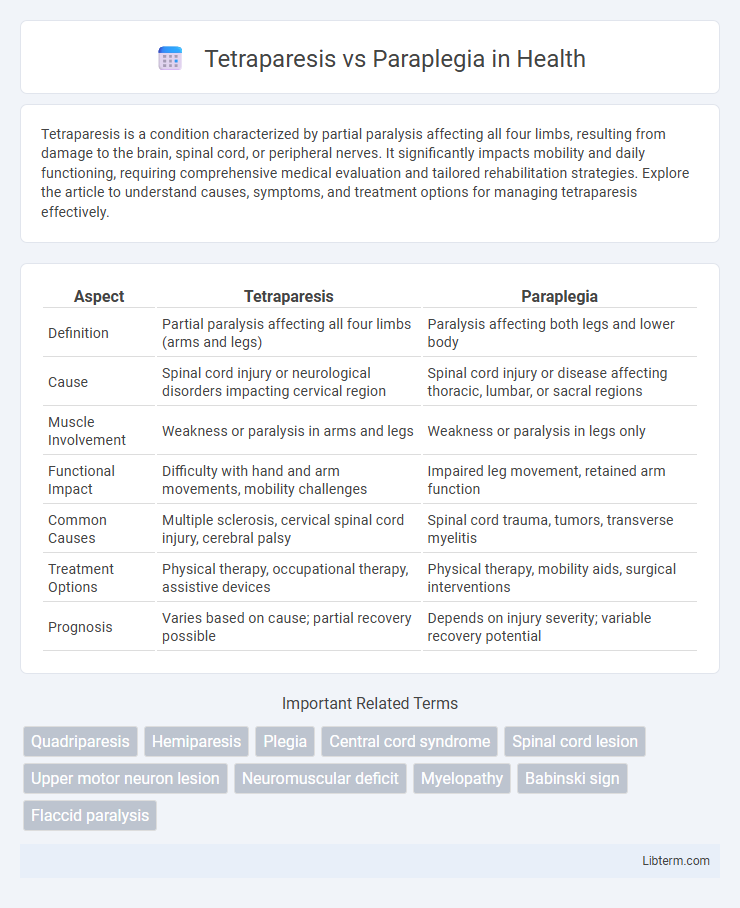Tetraparesis is a condition characterized by partial paralysis affecting all four limbs, resulting from damage to the brain, spinal cord, or peripheral nerves. It significantly impacts mobility and daily functioning, requiring comprehensive medical evaluation and tailored rehabilitation strategies. Explore the article to understand causes, symptoms, and treatment options for managing tetraparesis effectively.
Table of Comparison
| Aspect | Tetraparesis | Paraplegia |
|---|---|---|
| Definition | Partial paralysis affecting all four limbs (arms and legs) | Paralysis affecting both legs and lower body |
| Cause | Spinal cord injury or neurological disorders impacting cervical region | Spinal cord injury or disease affecting thoracic, lumbar, or sacral regions |
| Muscle Involvement | Weakness or paralysis in arms and legs | Weakness or paralysis in legs only |
| Functional Impact | Difficulty with hand and arm movements, mobility challenges | Impaired leg movement, retained arm function |
| Common Causes | Multiple sclerosis, cervical spinal cord injury, cerebral palsy | Spinal cord trauma, tumors, transverse myelitis |
| Treatment Options | Physical therapy, occupational therapy, assistive devices | Physical therapy, mobility aids, surgical interventions |
| Prognosis | Varies based on cause; partial recovery possible | Depends on injury severity; variable recovery potential |
Understanding Tetraparesis and Paraplegia
Tetraparesis involves partial weakness in all four limbs caused by damage to the cervical spinal cord or brain, often resulting from conditions like multiple sclerosis or stroke. Paraplegia primarily affects the lower half of the body, including both legs, due to injury or disease impacting the thoracic, lumbar, or sacral spinal cord regions. Differentiating between these neurological impairments is essential for targeted rehabilitation and treatment plans based on the extent and location of motor function loss.
Defining Tetraparesis: Causes and Symptoms
Tetraparesis, characterized by partial weakness in all four limbs, results from damage to the cervical spinal cord, brainstem, or brain regions controlling motor functions. Common causes include traumatic spinal cord injuries, multiple sclerosis, cerebral palsy, and strokes affecting the motor cortex. Symptoms often involve reduced muscle strength, impaired coordination, muscle spasticity, and difficulties with fine motor skills, distinguishing it from paraplegia, which affects only the lower limbs.
What is Paraplegia? Key Features and Causes
Paraplegia is a neurological condition characterized by the paralysis of the lower half of the body, typically affecting both legs and sometimes the lower trunk. Key features include loss of motor function and sensation below the level of spinal cord injury, often caused by trauma, spinal cord diseases, or congenital disorders such as spina bifida. The condition contrasts with tetraparesis, which involves weakness or paralysis of all four limbs.
Neurological Basis: How the Spinal Cord is Involved
Tetraparesis results from spinal cord injury or disease affecting the cervical region, causing weakness in all four limbs due to impaired neural signals. Paraplegia occurs with damage to the thoracic, lumbar, or sacral spinal cord segments, leading to paralysis or weakness primarily in the lower limbs. The extent and location of spinal cord involvement determine the severity and distribution of motor deficits in both conditions.
Diagnostic Criteria: Distinguishing Between Tetraparesis and Paraplegia
Tetraparesis is characterized by partial weakness affecting all four limbs, often diagnosed through clinical examination revealing impaired motor function and reflexes in both upper and lower extremities. Paraplegia involves paralysis primarily of the lower limbs, with diagnostic criteria emphasizing the extent of spinal cord injury or neurological deficit localized below the thoracic spinal segments. Neuroimaging techniques such as MRI and electromyography aid in differentiating these conditions by identifying lesion location and severity, crucial for accurate diagnosis and treatment planning.
Common Risk Factors and Underlying Conditions
Tetraparesis and paraplegia share common risk factors including spinal cord injury, multiple sclerosis, and stroke-related damage. Underlying conditions such as traumatic accidents, infections like transverse myelitis, and neurodegenerative diseases often contribute to both motor impairments. Vascular events and autoimmune disorders also play a significant role in the development of these neurological deficits.
Functional Impact: Mobility and Daily Living
Tetraparesis involves partial weakness in all four limbs, significantly restricting mobility and requiring assistance with daily activities such as dressing, eating, and personal hygiene. Paraplegia affects the lower limbs, often preserving upper body strength and allowing greater independence in daily tasks through adaptive devices. Both conditions necessitate tailored rehabilitation strategies to optimize functional capabilities and improve quality of life.
Treatment Approaches: Medical and Rehabilitation Options
Tetraparesis treatment involves comprehensive medical management including physical therapy, occupational therapy, and use of assistive devices to improve motor function in all four limbs, often combined with medications to manage spasticity and pain. Paraplegia treatment focuses on intensive rehabilitation targeting lower limb mobility and independence in daily activities, incorporating techniques such as functional electrical stimulation and wheelchair training. Both conditions benefit from interdisciplinary care teams, customized rehabilitation plans, and advancements in neurorehabilitation technologies to enhance quality of life and functional recovery.
Prognosis and Long-Term Outcomes
Tetraparesis involves partial paralysis affecting all four limbs, while paraplegia impacts only the lower limbs, with prognosis largely depending on injury severity and location. Long-term outcomes for tetraparesis often include greater motor and sensory impairment, requiring extensive rehabilitation and assistive devices, whereas paraplegia patients typically retain upper body function, facilitating greater independence. Advances in neurorehabilitation and assistive technology improve quality of life and functional recovery potential in both conditions, but tetraparesis generally presents more complex management challenges.
Support, Resources, and Living with Paralysis
Living with tetraparesis or paraplegia requires comprehensive support and access to specialized resources such as physical therapy, assistive technologies, and home modifications tailored to the level of paralysis. Tetraparesis patients often need more intensive care, adaptive equipment for both upper and lower limbs, and multidisciplinary medical teams to manage complex health challenges. Support networks including rehabilitation centers, community organizations, and online platforms play a crucial role in enhancing independence and quality of life for individuals with varying degrees of paralysis.
Tetraparesis Infographic

 libterm.com
libterm.com